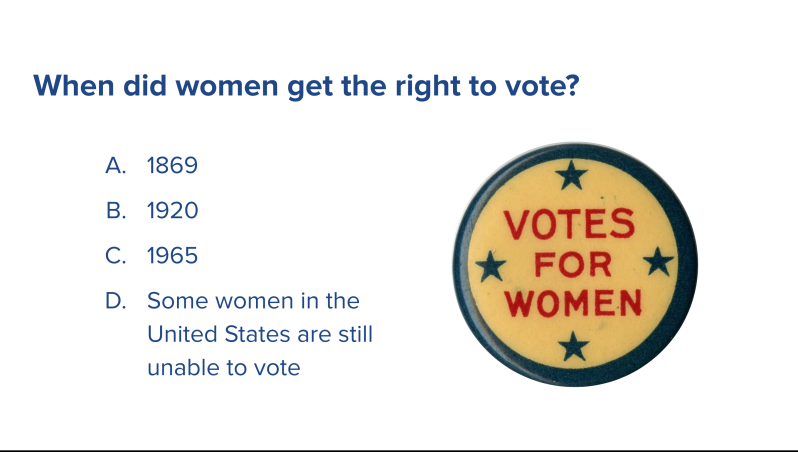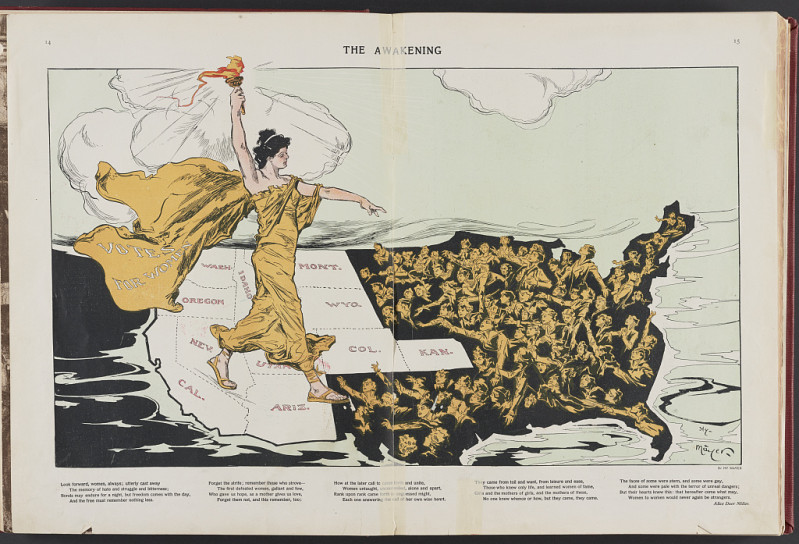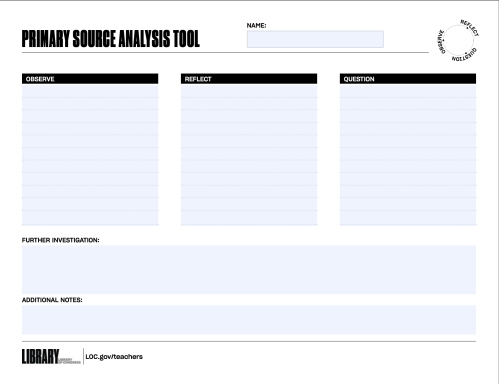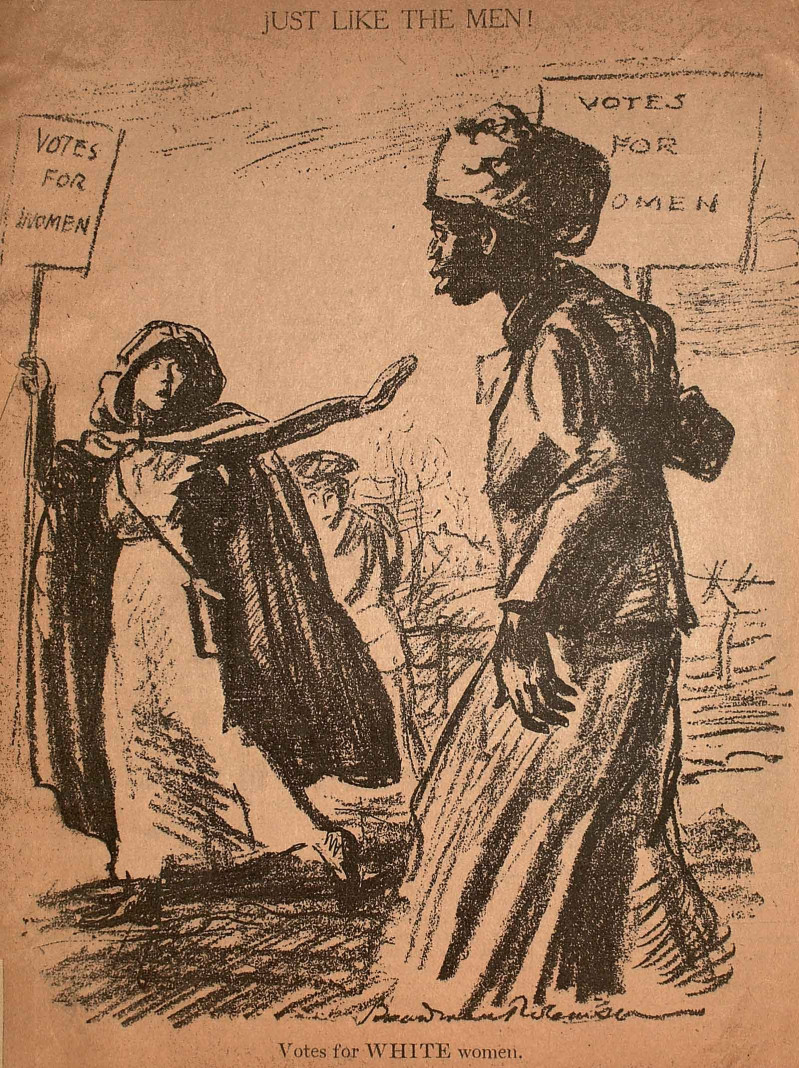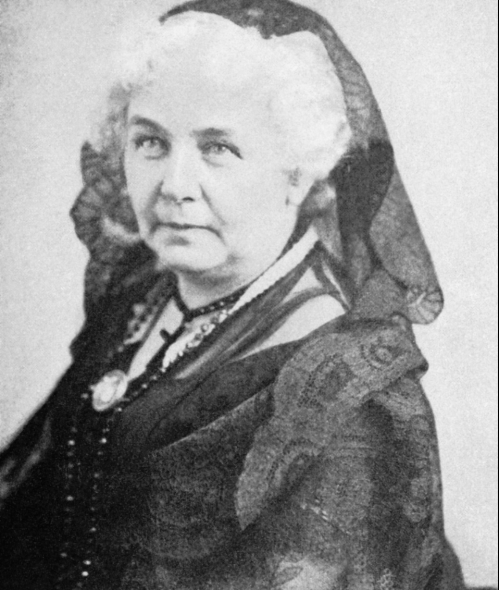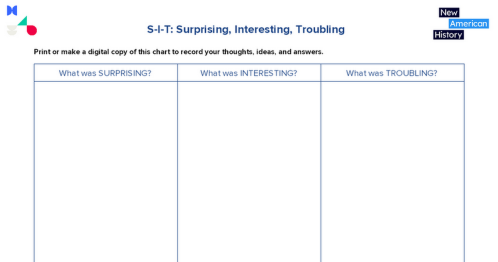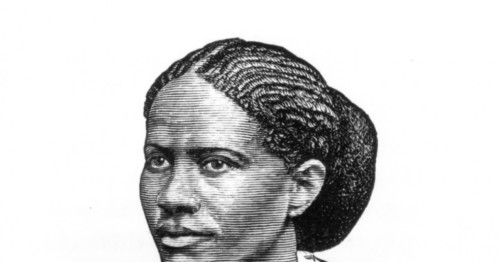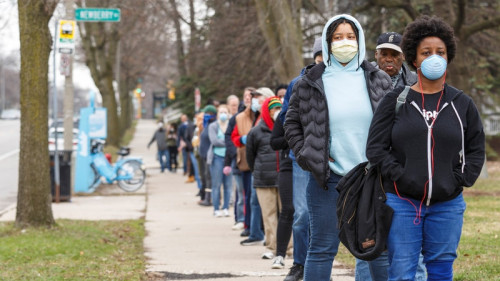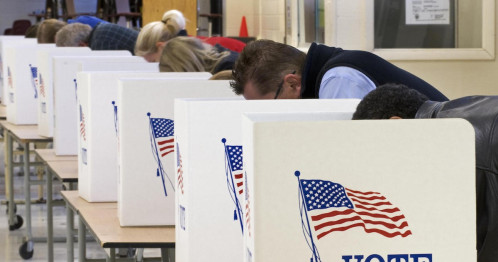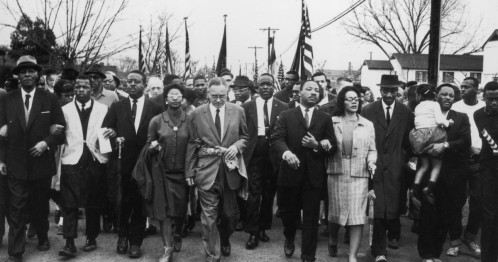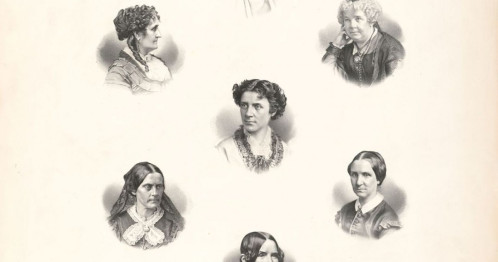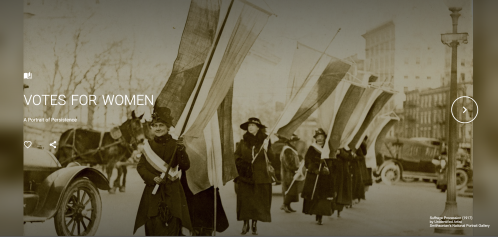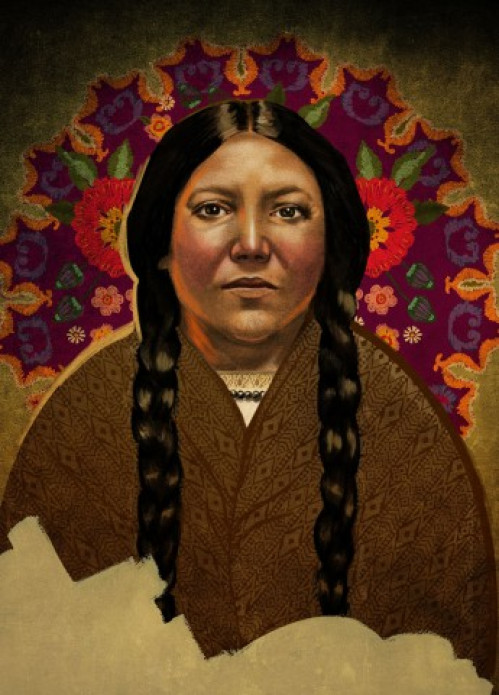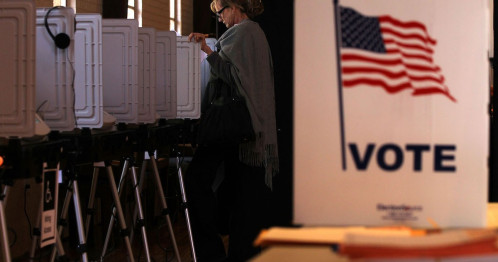This work by New American History is licensed under a Attribution-NonCommercial-ShareAlike 4.0 (CC BY-NC-SA 4.0) International License. Permissions beyond the scope of this license may be available at newamericanhistory.org.
Suffrage: Black Women and the Right to Vote
Read for Understanding:
Suffrage is the ability to vote in elections. Women in the United States have only had this right for just over one hundred years, which means they were not able to help select leaders for almost 150 years in the early republic and beyond. This lesson briefs you on the history of constitutional amendments leading up to women’s suffrage. Since its founding the United States has continued to try to suppress or disenfranchise – that is, prevent from voting – many groups, particularly Black people and women. We will also look at some of the historic activists in the suffrage movement that we rarely hear about, as well as look at current voting rights.
Key Vocabulary
Abolitionism - the movement to end slavery
Amendment - to officially change a document, law or policy, such as a Constitutional amendment
BIPOC - Black, Indigenous, and People of Color, an acronym meant to be more inclusive of marginalized and oppressed groups communities
Dilemma - a difficult situation or problem
Disenfranchise - taking away someone’s right to vote, usually by adopting policies and practices that block access to voting
Extralegal - actions or situations that are not regulated by the law
Legacy - a meaningful or lasting impact a person has on the world
Marginalized - put or kept in a position of powerlessness
Portrait - an image of a person made by an artist, often in a painting
Reconstruction amendments - the 13th, 14th, and 15th amendments, which were added to the Constitution after the Civil War
Suffragist - a person fighting for the right to vote
Voter suppression - strategies used to discourage specific groups of people from voting
Engage:
When did women get the right to vote?
Answer the poll shared by your teacher with your answer to this question.
Complete the Observe, Reflect, Question Primary Source Analysis Tool for Political Cartoons as you examine this image closely. Your teacher may ask you to download, print, or email your response.
Think about what more you want to know and how you might find out.
Your teacher may ask you to record your answers on an exit ticket.
Explore:
What was the impact of abolitionism and the Reconstruction amendments on the women’s suffrage movement?
Use your cropping tool to identify which portion of the image answers each question for you. (If working in the Google ecosystem, here are some simple directions for using the “Crop image” tool in Google Slides or Google Docs.)
- Identify the part of the image that first caught your eye.
- Identify a part of the image that shows an emotion.
- Identify a part of the image that shows a tension, problem, or dilemma.
- Identify a part of the image that makes you feel a strong emotional reaction or brings up questions for you.
- Identify the part of the image that best shows what this illustration is about.
Think-Pair-Share: (If working remotely, your teacher may use breakout rooms, an online chat or other collaboration tool such as Google Docs or Google Slides.)
- Think carefully on your own and give this image a new caption.
- Pair up with an elbow partner, sharing and explaining how or why you came up with your caption
- Share your captions with a small group or the whole class as directed by your teacher.
Listen to Lori Ginzberg discuss the divide between Black and White suffragists in an interview with NPR. As you listen, your teacher may ask you to use this graphic organizer to help you organize your thinking about the topic.
After the interview, navigate to Bunk History to explore how the women’s movement led by Elizabeth Cady Stanton and Susan B. Anthony made the decision to separate themselves from the work of abolitionists and Black suffragists after the Reconstruction amendments were ratified.
Start with this Bunk article: How the Daughters and Granddaughters of Former Slaves Secured Voting Rights for All
After you read the article, notice the stack of cards to the right of the excerpt. There are icons that may include a light bulb, person, or a clock next to the article that symbolize different types of connections you can make using Bunkhistory.org to learn more about history and current events. Take a few minutes to explore the cards and icons. You will notice that each icon leads you to a new stack of cards. To learn more about these, read How Connections Work.
As you explore the connections, create a Bunk collection of 3-5 articles that help explain the impact of racism and discrimination on the women’s suffrage movement.
When you find a thought-provoking Excerpt or Original, click the Add to Collection + button. Include a note describing the significance of the piece to your Collection. (Notes are shown when readers view a particular Excerpt or Original from your Collection. Your note should explain why you chose to include this article in your collection and how it shows a more complete history of women’s suffrage and the role of racism and discrimination in the movement.
While continuing your search, add more content to your Collection by clicking the Add to Collection + button on other Excerpts or Bunk Originals. Keep in mind: Collections are stored in your browser using cookies until they’re completed, so if you exit your browsing session or clear your cookies before completing, your Collection may be lost.
Once you’ve finished building your Collection, finalize your Collection by giving it a name and an optional description, and then click the Complete Collection button. Your teacher will explain how to share your collection with them.
Your teacher may ask you to record your answers on an exit ticket.
Explain:
How have government policies and voter suppression tactics been used to disenfranchise people since the founding of the United States?
Watch the Retro Report video How Black Women Fought Racism and Sexism for the Right to Vote
- Use the Connect, Extend, Challenge Chart to guide your thinking as you watch the video.
- Share your questions with another student and talk about what it was like to watch something that might have challenged your thinking.
Then, read The United States Isn’t a Democracy — And Was Never Intended to Be on Bunk. Click on the blue link “View on Made by History” at the bottom of the page to read the entire article. Keep track of how federal and state governments changed voting rights over time and some of the ways communities attempted to disenfranchise BIPOC voters through extralegal voter suppression tactics on this graphic organizer. Add to your notes as you explore more resources in the Voting Rights and Gerrymandering exhibit on Bunk.
How does the information you learned through your reading connect to the Retro Report video? Share your new learning with your classmates by completing the prompt: “I used to think… Now I Think…”
Your teacher may ask you to record your answers on an exit ticket.
Elaborate:
Who are the suffragists we rarely learn about in United States History?
Read How Women Got the Vote Is a Far More Complex Story Than the History Textbooks Reveal. How many names do you recognize? Pick the name of one of the suffragists you don’t know and find her portrait in the online exhibit, VOTES FOR WOMEN - Smithsonian's National Portrait Gallery.
Once you find it, your teacher will guide you to “read” the portrait through close examination of the setting, objects, colors, lighting, or other symbols. Then read the biographical text accompanying the portrait. How well does the portrait communicate her legacy to viewers? Share your thoughts with your class.
Now that you know more about reading portraits, take a few minutes to look through this entire exhibit on your own.
Select one portrait to examine more closely.
- What do you notice?
- What colors are used in the image? How do the different colors make you feel about the person in the image?
- Are there any objects in the image? What are they and why might they have been included in the picture?
- Is there anything in the background that gives you more information about the person in the image?
- What adjectives come to mind as you consider this person’s life, work, or personality?
- How well does the image illustrate the biographical text next to it?
- Is there anything in the text that you find surprising, interesting, or troubling?
Complete a 3-2-1 response to the figure you examined:
- 3 elements from the image that help the viewer better understand this person.
- 2 pieces of information from the text that either surprised, interested, or troubled you.
- 1 question you have about this person
Turn and talk to a neighbor. If you are completing this lesson virtually, you may be able to use the video conference chat feature or a discussion board posting to discuss it with your classmates. Describe your thoughts or feelings about the person you studied.
Now that you have a better understanding of the woman you chose, use your 3-2-1 response to craft a Six-Word Memoir for her. This memoir should tell the reader about the suffragist’s life, legacy, and significance. The tricky part is doing that in only six words! Check out Six-Word Memoirs – One Life, Six Words. What's Yours? to read real-life examples of people’s six-word memoirs and get some inspiration.
Your teacher may ask you to record your answers on an exit ticket.
Extend:
Who can vote in my state today?
Watch the TED-Ed video: The fight for the right to vote in the United States?
After watching the video, take a look at this resource on Bunk, The Missing Right: A Constitutional Right to Vote, about the current reality of voting rights. Think about what you have already learned about voting rights as you view and explore some of the connections, tags, and ideas presented in Bunk. As you explore, see if you can find the answers to some of these questions:
- Who is allowed to vote in my state?
- Who is prevented from voting in my state?
- Are BIPOC being disenfranchised at higher rates than White people in my state?
- What laws or policies are in place that make it harder for people to vote in my state?
- What laws or policies might make it easier for people to vote?
- Do I think it should be easier or harder for people to vote? Why?
- Are there any organizations in my state currently working to increase people’s access to voting?
- Who can I reach out to find out what is happening in my community?
Brainstorm a list of actions you could take in your community. Which will you commit to doing in the next few weeks?
Your teacher may ask you to record your answers on an exit ticket.
Citations:
Ault, Alicia. “How Women Got the Vote is a Far More Complex Story than the History Textbooks Reveal,” Smithsonian, April 9, 2019. Accessed August 4, 2020. https://www.bunkhistory.org/resources/4141.
"Connect, Extend, Challenge" Facing History and Ourselves. Accessed July 29, 2020. https://www.facinghistory.org/resource-library/teaching-strategies/.
"Crop It." Facing History and Ourselves. Accessed July 29, 2020. https://www.facinghistory.org/resource-library/teaching-strategies/connect-extend-challenge.
"The Fight for the Right to Vote in the United States." Video, 04:30. YouTube. Posted by TED-Ed, November 5, 2013. Accessed August 3, 2020. https://youtu.be/P9VdyPbbzlI.
"Hidden Figures of the Suffrage Movement." Brandywine River Museum of Art. Accessed July 29, 2020. https://www.brandywine.org/museum/hidden-figures-suffrage-movement.
Jones, Martha S. “How the Daughters and Granddaughters of Former Slaves Secured Voting Rights for All,” Smithsonian, March 8, 2019. Accessed August 4, 2020. https://www.bunkhistory.org/resources/3978.
Landis, Michael Todd. “The United States Isn’t a Democracy – And it was Never Intended to Be,” Made by History, November 6, 2018. Accessed August 4, 2020. https://www.bunkhistory.org/resources/3448.
Morning Edition. "For Stanton, All Women Were Not Created Equal." Hosted by Steve Inskeep. Aired July 13, 2011, on NPR. Accessed August 4, 2020. https://www.npr.org/2011/07/13/137681070/for-stanton-all-women-were-not-created-equal.
New York Tribune. "Just Like the Men!" The Nib. Last modified March 1, 1913. https://thenib.com/gallery-of-suffrage/.
Photograph of Woman Suffrage Button, ca 1910, PL.242991.051, National Museum of American History, Smithsonian. Accessed August 2, 2020. https://www.si.edu/object/woman-suffrage-button:nmah_1435219
Six-Word Memoirs. Accessed August 4, 2020. https://www.sixwordmemoirs.com/.
"S-I-T: Surprising, Interesting, Troubling." Facing History and Ourselves. Accessed July 29, 2020. https://www.facinghistory.org/resource-library/teaching-strategies/s-i-t-surprising-interesting-troubling.
Smithsonian's National Portrait Gallery, ed. "Votes for Women: A Portrait of Persistence." Google Arts and Culture. Accessed August 4, 2020. https://artsandculture.google.com/exhibit/2AKyZX3r7pZoJA.
Soros, Jonathan, and Mark Schmitt. "The Missing Right: A Constitutional Right to Vote." Democracy Journal, May 1, 2013. Accessed August 4, 2020. https://www.bunkhistory.org/resources/1138.
“Voting Rights and Gerrymandering.” Bunk History. Accessed August 4, 2020. https://www.bunkhistory.org/exhibits/15.



